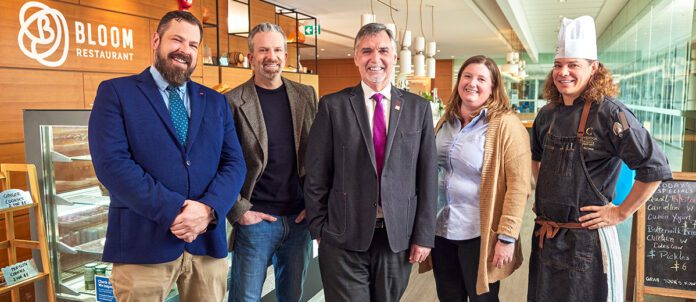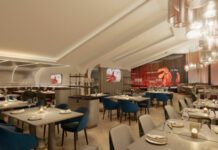
By Nicole Di Tomasso
Bloom Restaurant, an interactive live classroom located within Conestoga College’s School of Hospitality & Culinary Arts in Waterloo, Ont., has transformed into a climate action Living Lab to provide solutions to reduce greenhouse-gas (GHG) emissions as they relate to food, food waste and packaging.
Starting in 2022, a team of faculty, researchers and students collaborated to develop a model to input current and future recipes to determine ingredient GHGs. As a result, Bloom became the first restaurant in Canada to display GHG emissions icons on its menu. As this year’s recipient of Kostuch Media’s Green Leadership Award, Bloom is a leading example for restaurateurs seeking ways to re-build their business to ensure a sustainable future.
“We were fortunate to be one of the first 10 colleges in Canada to receive a grant through Colleges and Institutes Canada,” says Nicole Detlor, director, Conestoga Food Research and Innovation Lab. “The funding allowed us to hire student researchers who helped with the initial project research and menu labelling. We started by looking at literature to find credible data and then built a tool for culinary staff. We’ve since purchased Klimato software, which aligned with our vision from the beginning, but it didn’t exist when we started out. Everything seemed to happen at the same time.”
Initially, the model was developed using open-source, peer reviewed life-cycle analysis data of food items. Chefs enter their menu into the model and the GHG emissions are calculated. On Bloom’s menu, the results are communicated by icons indicating a low, medium or high quantity of GHGs in each dish.
In December 2023, Conestoga College became the first academic institution, and among a short list of restaurants, in North America to purchase a license for Sweden-based Klimato, a software company helping food businesses calculate their GHG impact. To advance Bloom’s efforts, the Klimato system was implemented in January 2024.
“Finding the initial data was challenging. It was a daunting task,” says Detlor. “However, Klimato software is a great example of making this data accessible and meaningful. They have a great science team backing them and have added even more North American ingredients to serve our region.”
Bloom operates in seven-week cycles and offers two or three-course options. “Half of the menu will be updated every term, so it evolves seasonally and with the intention of giving students the opportunity to learn new skills when they come back for their second year,” says executive chef Dan McCowan.
Generally, menu items containing meat products have high quantities of GHG emissions while plant-based foods have low quantities. Examples from Bloom’s spring 2024 menu include Coq au Vin (high), a red-wine soaked Cornish hen with parsnip purée, fingerlings, roasted pearl onion, bacon lardons, honey mushrooms, arugula and parmesan salad and red-wine jus; Bacon & Brussels (medium), featuring crispy smoked pork belly, cider glazed Brussels sprouts, goat cheddar, toasted pine nuts and gala apple; and Vegan Moussaka (low), a panko-breaded and fried eggplant with tempeh “Bolognese”, cashew cream, pickled turnip and herb salad.
“I joined about half-way through the initial project, but it has become addictive,” says McCowan. “When I’m creating the menu, I want to see the lows become lower and I want to ensure we’re using things that are in the curriculum. We re-purpose some items that come from the butchery to use as much as we can in-house.”
However, McCowan notes, “The low, medium and high GHG icons on the menu aren’t meant to guilt people for ordering things that are high. The goal is to start a conversation and allow people to understand where we’re headed.”
With regard to food waste at Bloom, a waste audit was conducted in fall 2022 by faculty and students in the college’s Sustainability Business Management program. The team found that organics made up 76 per cent of the total waste and recycling accounted for three per cent of the waste measured, with only 15 per cent contaminated. Students provided 25 recommendations for consideration and several projects have been initiated and/or completed to date, such as reducing the contamination level in the organics stream, reducing the quantity of plastic wrap and using a juicer to convert fruits used for zest into juice for other applications.
The following year, additional plate-waste audits were conducted as part of the Global Hospitality Management program. The audit found that plate waste often include side-dish carbohydrates, such as bread, potatoes and ingredients for coffee service. Adjustments included offering less bread, condiments and dairy, as well as reducing portion sizes.
Another priority area for the project was eliminating single-use containers. In September 2022, Bloom partnered with Guelph, Ont.-based A Friendlier Company Inc. to provide the restaurant’s take-out counter with re-usable containers. To date, nearly 4,000 containers have been re-used, diverting 507 lbs. of plastic waste, saving 32,150 litres of water and preventing GHG emissions equivalent to driving a car from the college campus to Calgary from being released into the environment.
Undoubtedly, the complexity of this project has presented a number of challenges, but the team’s passion and sense of responsibility are key drivers of its success.
“With regard to packaging, one of the ongoing challenges is finding solutions that have minimum order quantities we can work with,” says Detlor. “We’ve looked at more sustainable options for packaging, but the minimum-order quantities are about five years worth of supply. It’s not feasible and we don’t have enough storage space.”
“Some packaging is labelled compostable but when you look into it further, it’s not. Coffee cups, for example, have a lining or coating on the inside that can’t be recycled,” says says Keith Müller, Dean, School of Hospitality & Culinary Arts, and Institute of Food Processing Technology; Conestoga College. “We’re always searching for alternatives that are more viable, compostable, et cetera. Bloom runs a grab-and-go too, so finding [alternatives] that can package baked goods and still have a protective barrier is a challenge. I don’t think it’ll ever be perfect but we’re always aiming for perfect.”
“One of the challenges from my perspective is finding (products) I’m excited about and then realizing they don’t ship to Canada yet,” says McCowan. “There’s a million different ways we can improve, such as sourcing a sustainable takeout ramekin bowl for a side sauce, but it has been a great experience so far.”
Among its other sustainability efforts, a geo-thermal heating system is currently being installed at the Bloom campus, which is anticipated to go online in 2025. Additionally, Bloom has linen-free table settings and only requires laundering for re-usable cloth napkins. Motion sensors for lights as well as light dimmers have been installed to reduce energy consumption where possible. To conserve water, all taps in restrooms are either sensor activated or timed.
Moving forward, McCowan says he looks forward to refining Bloom’s menu. “The difference between legumes and rice is quite dramatic in terms of the GHGs that are produced. As the menu evolves, there will be a lot of ways to create dishes that can lower GHGs without focusing solely on meat proteins. That’s where the next phase comes in from my perspective.”
“We weren’t that confident in our model at the beginning. We knew it had to be adjusted, but partnering with Klimato software has helped justify what we did and now we say with confidence that this is a model that restaurants can move forward with,” says Müller. “This is a project that has brought us a long way from where we were, but we’re not stopping here.”
















